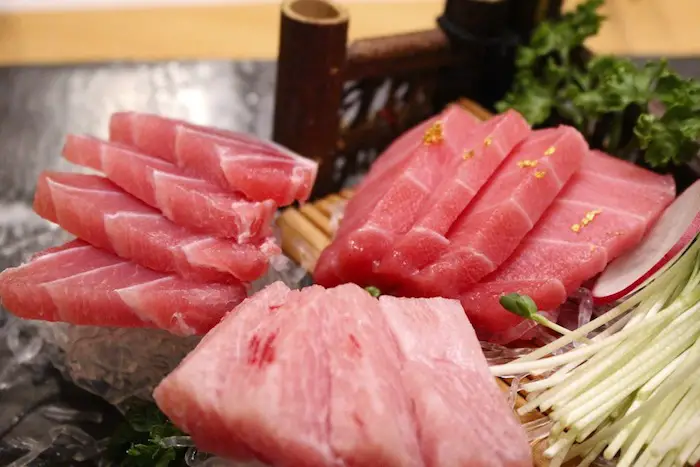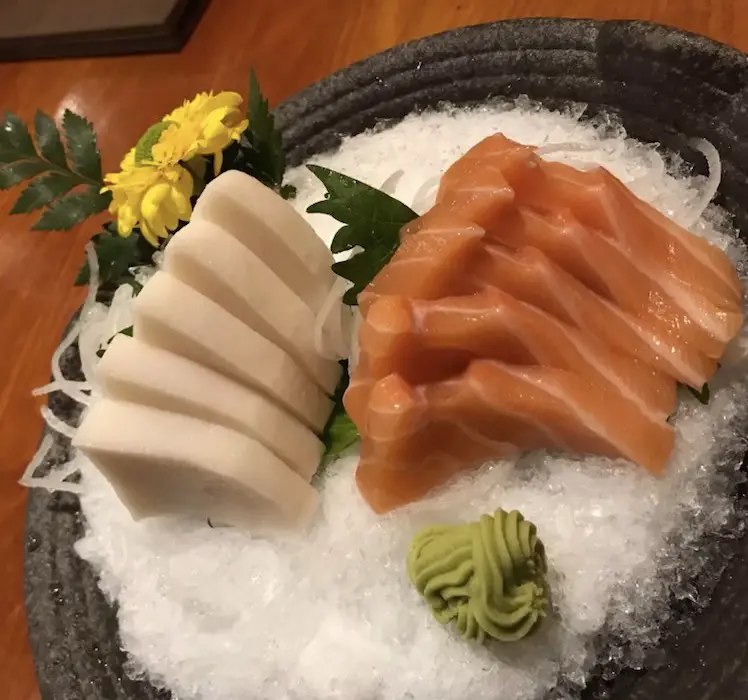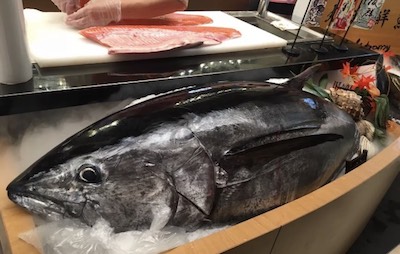We are reader supported. When you purchase through links on our site, we may earn an affiliate commission. Also, as an Amazon affiliate, we earn from qualifying purchases.

For some people, tuna and sushi are inseparable, and why not? After all, it is one of the most popular sushi rolls in Japan. Interestingly, before the Edo period, tuna was considered as a poor man’s food but the popularity of tuna sushi roll changed the scenario and today it is one of the highly prized delicacies at sushi restaurants.
Sushi beginners often ask me ‘do I need to cook tuna for sushi’. My answer is ‘No’, if the fish is sushi-grade. The traditional tuna sushi roll comprises of raw tuna with seasoned rice and nori. However, tuna may be seared or grilled to kill parasites and enhance the flavors.
If you are an ardent tuna fan, then this article will help you gain an insight into the different types of tuna meat used in the Japanese delicacy. I will also discuss the various ways in which you may marinate and cook tuna for various sushi rolls.
Contents
Raw Tuna In Sushi Recipes

Most of the traditional tuna sushi recipes use raw tuna and for this, you will need to buy sushi-grade fish from the market. Make sure you buy only from a trusted fishmonger that sells highest quality tuna that were flash-frozen at extremely low temperatures soon after being caught.
The latest technology used in freezing fish ensures that the quality (flavor or texture) is not degraded and the freshness stays intact. If you can’t find sushi-grade tuna in your local fish market, consider buying it online from trusted sites like Catalina Offshore Products.
4 Reasons To Cook Tuna For Sushi
While tuna fish is mostly used raw in nigiri and sushi rolls, you may need to cook the fish under some scenarios, like the ones mentioned below.
If you live in a place where the local fishmonger or supermarket do not have sushi-grade fish and you are craving for tuna sushi, consider using cooked regular tuna meat. Make sure you thoroughly cook the meat to kill any parasites that may be present before using it to make sushi.
If you bought sushi-grade fish but ended up storing it in the freezer for more than 24 hours, you will need to cook the fish before using it in sushi rolls. The home freezer does not have high capacity like commercial freezers, hence it’s better not to risk your health.
If you are a sushi beginner and raw meat makes you uncomfortable, try the cooked variations of tuna. While raw tuna slices are freaking amazing, the cooked options also taste great.
If you planned a sushi party for friends and ended up with a lot of leftover raw fish, store it inside the refrigerator. Next morning, cook the fish and use the remaining sushi rice to prepare a filling chirashi breakfast.
Different Cuts Of Tuna Used In Sushi
Tuna is a large fish and meat cut from different parts of the body taste differently due to varying fat content. In sushi, three types of tuna meat are used and each of them has its own distinct characteristics.
#1. Akami
The tuna sushi rolls they serve at the grocery stores and supermarket typically contains the akami portion, which is the tail part of tuna. As this part of the body gets a lot of exercises, the red-colored meat is lean and low in fat.
If you order a tuna nigiri or roll at a sushi restaurant, you will receive this cut as it’s easily available and reasonably priced. The akami meat may not be as delicate as the other cuts of tuna, but it has a mild flavor and great taste in both raw and cooked state.
#2. Otoro
This is the most prized cut of tuna used in making nigiri and other types of sushi. As this meat comes from near the stomach area, it has a higher level of fat. The raw flesh is so delicate that it practically melts into the mouth. The taste of otoro is slightly sweeter and has a more luscious texture than other cuts. Due to its rich flavors, otoro tuna is highly-priced but it’s worth it when you take a bite.
#3. Chutoro
If you find the otoro pieces too fatty or sweet then you must opt for Chutoro, which has a more moderate fat content. The meat is tender and has delicate flavors but the fattiness is balanced by its meaty texture. There’s only a small portion of Chutoro meat in tuna and due to this, it costs more than akami but less than the otoro cuts.
Importance Of Tuna In Sushi Restaurants
In a traditional sushi restaurant, tuna is considered as the signature fish which defines the style, quality, and originality of the Japanese delicacy. As a result, some master chefs consider selecting and buying the right quality tuna from the fish market as one of their most important tasks.
Tuna meat, particularly the highly prized otoro cuts are often considered as the highlight of an ‘omakase’ meal, similar to the most popular dish in French or Italian fare. To, a sushi traditionalist, a restaurant that does not have maguro or tuna is not an authentic sushi place.

Whether you order tuna sushi at a restaurant or buy sushi-grade tuna to make sushi at home, you will typically get the maguro meat from three different species belonging to the tuna family – Yellowfin, Blue Fin, and Big Eye tuna. In the US and some places in Japan, they also use Albacore Tuna for sushi, and it is typically labeled as white tuna.
Preparing Tuna For Nigiri and Sushi Rolls
When you buy sushi-grade tuna from the fishmonger or supermarket, they will usually give you a block of tuna that is known as Saku. After you reach home, wash the tuna meat in cold water, pat dry and thaw it by keeping inside the refrigerator for 3-10 hours or overnight.
To de-frost quickly, keep the meat under running tap water (cold). Once, thawed, pat dry and put the block on the kitchen table. If you look closely, you can see grains on the red meat. To cut sashimi-style slices for nigiri sushi, you will need to cut against the grain at a 30-degree angle.
You will need a sharp Japanese knife and cut the tuna block into ¼ inch thick slices. One of the most important aspects is to consider how thick or thin slices you must cut for sushi, as this will dramatically influence the taste of nigiri. I would suggest that you cut a slightly thicker slice to get that rich flavor.
If the cut is too thin, you will lose the essence of raw tuna in the delicacy. When cutting a block of tuna, pull the knife back towards you instead of pushing it to the front. This will give you a more precise cut. To use tuna in sushi rolls, cut out thick strips instead of slices.
In some tuna sushi recipes, the instructions may tell you to cut tuna into small cubes and then mix it with soy sauce and other seasonings to marinate the fish. While tuna is mostly used raw in sushi, you may cook the meat in different ways to prepare a cooked sushi roll.
Ways To Cook Tuna For Sushi Dishes
Searing tuna:
One of the most popular ways of cooking tuna for sushi is by searing the meat. To do this, first season the tuna fillets with salt, cayenne or shichimi, and marinate it in shoyu (soy sauce) for 5-10 minutes. Put a skillet on medium heat and add about 1 tablespoon of oil to it. Now, sear the tuna fillets on both sides for 1-1.5 minutes each.
Tuna Steak:
Season a tuna block with pepper and then press it over crushed sesame seeds. Now, put a frying pan on the stove and add a little vegetable oil to it. Add some sesame seeds to the oil for a more roasted flavor. Now, put the tuna meat over the heated oil and let it cook for at least 2 minutes on both sides. The meat should be more than half-way cooked with a crusty topping and brown shade.
Tuna Dressed In Soy And Lime:
In a bowl, add one small shallot (minced), ½ teaspoon freshly grated ginger, 1/3 cup soy sauce, black pepper, 1/3 cup lime juice, 1/3 cup olive oil, and freshly ground pepper. Heat a frying pan and add peanut oil to it. Place the tuna slices on the oil and when it’s slightly seared, drizzle the ginger-soy-lime mix on the meat, cook for 2 minutes on both sides.
Grilled Tuna:
Grilling tuna will make the meat very delicate but if you wish to cook tuna before adding to your sushi roll, here are the quick steps. Please note that you can’t use grilled tuna on nigiri sushi as the soft texture of the cooked meat may make it fall apart.
In a bowl, take ¼ cup of orange juice, ¼ cup of soy sauce, 2 tbsp olive oil, 1 tbsp lemon juice, chopped parsley, finely minced garlic, and 1/2 teaspoon pepper. Add medium-sized blocks of tuna to the marinade and let them sit inside the refrigerator for 30 minutes.
Preheat the oven to a high setting, brush some oil on the grills and place the tuna piece over it. Cook for at least 5-6 minutes, flip it to the other side in between. When both sides are well roasted, you may either shred it into small pieces or cut into strips and use as fillings in sushi.
Canned Tuna Filling:
Canned tuna contains cooked tuna meat in salty water and oil (olive oil or vegetable oil). To prepare tuna filling for sushi, drain the excess water and oil and put the chunks of tuna in a bowl. Use a fork to shred the chunk into small pieces. Mix with a half cup of Japanese mayonnaise.
Another method is to mix 1 tsp of Sriracha sauce and 1 tsp of toasted sesame oil in a bowl. Squirt a little soya sauce and lemon juice. Add the drained tuna to the sauce and mix evenly. You may add a spoon of masago for the crunchy effect. Now, add this to your sushi roll.
Related Questions
Where can I find sushi-grade tuna
You can find sushi-grade tuna in the local fish market or reliable online store like Catalina Offshore Products. Sushi-grade tuna can be eaten raw but if it’s not the highest quality, you must cook the fish to kill any parasites that may be present. I have created an article that explains – what is sushi-grade tuna.
How to tell if the tuna is safe for raw consumption?
Color is not the right indicator of freshness because tuna meat may be artificially colored to look red and appealing. Bring it close to your nose and smell it. Good quality tuna will smell like the sea, not fishy. If you get a fishy odor, the meat is not safe for raw consumption.
Why is white tuna so cheap?
If you find white tuna at a cheap price at the fish market, please be aware as there’s nothing called white tuna. It’s either Albacore or Escolar fish, which is known for causing for gastrointestinal symptoms. Read my article that explains what is white tuna and the marketing gimmick fish markets/ restaurants use to mislabel other fish as tuna.

